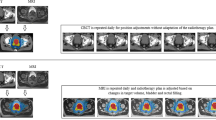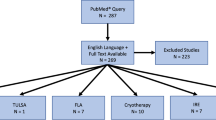Abstract
This article on permanent iodine-125 seed prostate brachytherapy reviews the techniques, results, and patient selection issues for early prostate cancer. The long-term 10 y results of brachytherapy from Seattle, and their reproducibility in other centres both in the USA and UK are reported. The use of hormone therapy in brachytherapy and the value of combining external beam radiotherapy with a brachytherapy implant are discussed. Reviewed comparative data show the similarity of biochemical survival in patients treated with brachytherapy, radical prostatectomy, and external beam radiotherapy. The role of brachytherapy as a first-line treatment option for patients with prostate cancer is demonstrated.
This is a preview of subscription content, access via your institution
Access options
Subscribe to this journal
Receive 4 print issues and online access
$259.00 per year
only $64.75 per issue
Buy this article
- Purchase on Springer Link
- Instant access to full article PDF
Prices may be subject to local taxes which are calculated during checkout


Similar content being viewed by others
References
Holm HH et al. Transperineal 125iodine seed implantation in prostatic cancer guided by transrectal ultrasonography. J Urol 1983; 130: 283–286.
Zelefsky MJ, Whitmore Jr WF . Long-term results of retropubic permanent 125iodine implantation of the prostate for clinically localized prostatic cancer. J Urol 1997; 158: 23–29, discussion 29–30.
Cha CM et al. Isotope selection for patients undergoing prostate brachytherapy. Int J Radiat Oncol Biol Phys 1999; 45: 391–395.
Wallner K et al. 1-125 vs Pd-103 for low-risk prostate cancer: morbidity outcomes from a prospective randomized multicenter trial. Cancer J 2002; 8: 67–73.
Grimm PD, Blasko JC, Ragde H . Ultrasound-guided transperineal implantation of iodine-125 and palladium-103 in the treatment of early stage prostate cancer. Technical concepts in planning, operative technique and evaluation. Urol Clin North Am 1994; 2: 113–125.
Ragde H et al. Ten-year disease free survival after transperineal sonography-guided iodine-125 brachytherapy with or without 45-gray external beam irradiation in the treatment of patients with clinically localized, low to high Gleason grade prostate carcinoma. Cancer 1998; 83: 989–1001.
Grimm PD et al. 10-year biochemical (prostate-specific antigen) control of prostate cancer with (125)I brachytherapy. Int J Radiat Oncol Biol Phys 2001; 51: 31–40.
Blasko JC et al. The role of external beam radiotherapy with I-125/Pd-103 brachytherapy for prostate carcinoma. Radiother Oncol 2000; 57: 273–278.
Sylvester JE et al. Ten-year biochemical relapse-free survival after external beam radiation and brachytherapy for localized prostate cancer: the Seattle experience. Int J Radiat Biol 2003; 57: 944–952.
Potters L et al. Importance of implant dosimetry for patients undergoing prostate brachytherapy. Urology 2003; 62: 1073–1077.
Ragde H, Gardo GL, Nadir B . Brachytherapy for clinically localized prostate cancer: thirteen year disease-free survival of 769 consecutive prostate cancer patients with permanent implants alone. Arch Esp Urol 2001; 54: 739–747.
Potters L et al. Risk profiles to predict PSA relapse-free survival for patients undergoing permanent prostate brachytherapy. Cancer J Sci Am 1999; 5: 301–306.
Zelefsky MJ et al. Five-year biochemical outcome and toxicity with transperineal CT-planned permanent 1-125 prostate implantation for patients with localized prostate cancer. Int J Radiat Oncol Biol Phys 2000; 47: 1261–1266.
Lederman GS et al. Retrospective stratification of a consecutive cohort of prostate cancer patients treated with a combined regimen of external-beam radiotherapy and brachytherapy. Int J Radiat Oncol Biol Phys 2001; 49: 1297–1303.
Peschel R, Han S, Colberg J . Ultrasound guided transperineal implant (IMP) vs radical prostatectomy for early prostate cancer. Int J Radiat Biol 2001; 51 (Suppl 1): 292.
Kollmeier M, Stock R, Stone N . Biochemical outcomes after prostate brachytherapy with 5-year minimal follow-up: improtance of patient selection and implant quality. Int J Radiat Biol 2003; 57: 645–653.
D'Amico AV et al. Biochemical outcome after radical prostatectomy, external beam radiation therapy, or interstitial radiation therapy for clinically localized prostate cancer. JAMA 1998; 280: 969–974.
Lee LN, Stock RG, Stone NN . Role of hormonal therapy in the management of intermediate- to high-risk prostate cancer treated with permanent radioactive seed implantation. Int J Radiat Oncol Biol Phys 2002; 52: 444–452.
Kwok Y et al. Risk group stratification in patients undergoing permanent (125)I prostate brachytherapy as monotherapy. Int J Radiat Oncol Biol Phys 2002; 53: 588–594.
Merrick GS et al. Biochemical outcome for hormone-naive patients with Gleason score 3+4 vs 4+3 prostate cancer undergoing permanent prostate brachytherapy. Urology 2002; 60: 98–103.
Potters L et al. A comprehensive and novel predictive modeling technique using detailed pathology factors in men with localized prostate carcinoma. Cancer 2002; 95: 1451–1456.
Brachman DG et al. Failure-free survival following brachytherapy alone or external beam irradiation alone for T1-2 prostate tumors in 2222 patients: results from a single practice. Int J Radiat Oncol Biol Phys 2000; 48: 111–117.
Bottomley DM, Ash D . Prostate Brachytherapy Leeds 7 year results, B.S.o. Oncology Birmingham 2003.
Blasko JC et al. Palladium-103 brachytherapy for prostate carcinoma. Int J Radiat Oncol Biol Phys 2000; 46: 839–850.
Davis BJ et al. The radial distance of extraprostatic extension of prostate carcinoma: implications for prostate brachytherapy. Cancer 1999; 85: 2630–2637.
Henderson A, Langley SEM, Laing R . Is bicalutamide equivalent to goserelin for prostate volume reduction before radiation therapy? A prospective observational study. Clin Oncol 2003; 15: 318–321.
Pilepich MV, Winter K, John MJ . Phase III radiation therapyoncology group (RTOG) trial 86-10 of androgen deprivation adjuvant to definitive radiotherapy in locally advanced prostate cancer. Int J Radiat Biol 2001; 50: 1243–1252.
Horwitz E et al. Subset analysis of RTOG 85-31 and 86-10 indicated an advantage for long-term vs short-term adjuvant hormones for patients with locally advanced nonmetastatic prostate cancer treated with radiation therapy. Int J Radiat Biol 2001; 49: 947–956.
Sylvester J et al. Short-course androgen ablation combined with external-beam radiation therapy and low-dose-rate permanent brachytherapy in early-stage prostate cancer: a matched subset analysis. Mol Urol 2000; 4: 155–159, discussion 161.
Potters L et al. Examining the role of neoadjuvant androgen deprivation in patients undergoing prostate brachytherapy. J Clin Oncol 2000; 18: 1187–1192.
Wallner K, Blasko J, Dattoli M . Prostate Brachytherapy made Complicated, 2nd edn. SmartMedicine, Seattel 2002.
Merrick GS et al. Prostate-specific antigen spikes after permanent prostate brachytherapy. Int J Radiat Oncol Biol Phys 2002; 54: 450–456.
Stock RG, Stone NN, Cesaretti JA . Prostate-specific antigen bounce after prostate seed implantation for localized prostate cancer: descriptions and implications. Int J Radiat Oncol Biol Phys 2003; 56: 448–453.
Vicini FA et al. An interinstitutional and interspecialty comparison of treatment outcome data for patients with prostate carcinoma based on predefined prognostic categories and minimum follow-up. Cancer 2002; 95: 2126–2135.
Sharkey J et al. Brachytherapy vs radical prostatectomy in patients with clinically localized prostate cancer. Curr Urol Rep 2002; 3: 250–257.
Kupelian PA et al. Radical prostatectomy, external beam radiotherapy <72 Gy, external beam radiotherapy >72 Gy, permanent seed implantation, or combined seeds/external beam radiotherapy for stage T1–T2 prostate cancer. Int J Radiat Oncol Biol Phys 2002; 54: 38 (61).
Ragde H et al. Modern prostate brachytherapy Prostate specific antigen results in 219 patients with up to 12 years of observed follow-up. Cancer 2000; 89: 135–141.
Pound CR et al. Natural history of progression after PSA elevation following radical prostatectomy. JAMA 1999; 281: 1591–1597.
Henderson A et al. Toxicity and early biochemical outcomes from 125Iodine prostate brachytherapy in the UK. Clin Oncol 2004; 16: 95–104.
Ragde H et al. Brachytherapy for clinically localized prostate cancer: results at 7- and 8-year follow-up. Semin Surg Oncol 1997; 13: 438–443.
Terk MD, Stock RG, Stone NN . Identification of patients at increased risk for prolonged urinary retention following radioactive seed implantation of the prostate. J Urol 1998; 160: 1379–1382.
Beyer DC, Priestley Jr JB . Biochemical disease-free survival following 125I prostate implantation. Int J Radiat Oncol Biol Phys 1997; 37: 559–563.
Merrick GS et al. Prophylactic versus therapeutic alpha-blockers after permanent prostate brachytherapy. Urology 2002; 60: 650–655.
Merrick GS et al. Temporal resolution of urinary morbidity following prostate brachytherapy. Int J Radiat Oncol Biol Phys 2000; 47: 121–128.
Hu K, Wallner K . Urinary incontinence in patients who have a TURP/TUIP following prostate brachytherapy. Int J Radiat Oncol Biol Phys 1998; 40: 783–786.
Merrick GS et al. Rectal function following prostate brachytherapy. Int J Radiat Oncol Biol Phys 2000; 48: 667–674.
Gelblum DY, Potters L . Rectal complications associated with transperineal interstitial brachytherapy for prostate cancer. Int J Radiat Oncol Biol Phys 2000; 48: 119–124.
Augustin H et al. Patient self-reporting questionnaire on urological morbidity and bother after radical retropubic prostatectomy. Eur Urol 2002; 42: 112–117.
Bates TS, Wright MP, Gillatt DA . Prevalence and impact of incontinence and impotence following total prostatectomy assessed anonymously by the ICS-male questionnaire. Eur Urol 1998; 33: 165–169.
Steineck G et al. Quality of life after radical prostatectomy or watchful waiting. N Engl J Med 2002; 347: 790–796.
Potters L et al. Potency after permanent prostate brachytherapy for localized prostate cancer. Int J Radiat Oncol Biol Phys 2001; 50: 1235–1242.
Merrick GS et al. Efficacy of sildenafil citrate in prostate brachytherapy patients with erectile dysfunction. Urology 1999; 53: 1112–1116.
Stock RG, Kao J, Stone NN . Penile erectile function after permanent radioactive seed implantation for treatment of prostate cancer. J Urol 2001; 165: 436–439.
Jani AB, Hellman S . Early prostate cancer: clinical decision-making. Lancet 2003; 361: 1045–1053.
Davis JW et al. Quality of life after treatment for localized prostate cancer: differences based on treatment modality. J Urol 2001; 166: 947–952.
Fulmer BR et al. Prospective assessment of voiding and sexual function after treatment for localized prostate carcinoma: comparison of radical prostatectomy to hormonobrachytherapy with and without external beam radiotherapy. Cancer 2001; 91: 2046–2055.
Ash D et al. ESTRO/EAU/EORTC recommendations on permanent seed implantation for localized prostate cancer. Radiother Oncol 2000; 57: 315–321.
Nag S . Brachytherapy for prostate cancer: summary of American Brachytherapy Society recommendations. Semin Urol Oncol 2000; 18: 133–136.
Kestin LL et al. Percentage of positive biopsy cores as predictor of clinical outcome in prostate cancer treated with radiotherapy. J Urol 2002; 168: 1994–1999.
Crook J et al. Factors influencing risk of acute urinary retention after TRUS-guided permanent prostate seed implantation. Int J Radiat Oncol Biol Phys 2002; 52: 453–460.
Peschel R, Colberg J . Surgery, brachytherapy and external-beam radiotherapy for early prostate cancer. Lancet Oncol 2003; 4: 233–241.
Author information
Authors and Affiliations
Corresponding author
Rights and permissions
About this article
Cite this article
Langley, S., Laing, R. Iodine seed prostate brachytherapy: an alternative first-line choice for early prostate cancer. Prostate Cancer Prostatic Dis 7, 201–207 (2004). https://doi.org/10.1038/sj.pcan.4500727
Received:
Revised:
Accepted:
Published:
Issue Date:
DOI: https://doi.org/10.1038/sj.pcan.4500727
Keywords
This article is cited by
-
The efficacy of iodine-125 permanent brachytherapy versus intensity-modulated radiation for inoperable salivary gland malignancies: study protocol of a randomised controlled trial
BMC Cancer (2016)
-
Iodine-125 brachytherapy improved overall survival of patients with inoperable stage III/IV non-small cell lung cancer versus the conventional radiotherapy
Medical Oncology (2015)
-
Preparation and deployment of indigenous 125I-seeds for the treatment of prostate cancer: Dawn of prostate brachytherapy in India
Journal of Radioanalytical and Nuclear Chemistry (2014)



